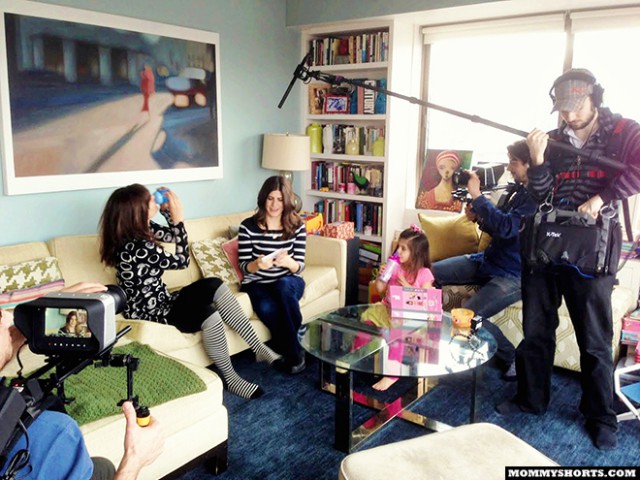 Today's early childhood development question deals with the dreaded morning diaper change. (Is anybody else tortured daily by this like I am?)
Today's early childhood development question deals with the dreaded morning diaper change. (Is anybody else tortured daily by this like I am?)
Mazzy HATES to be changed right after she wakes up. If I take her directly from the crib to the changing table, she breaks into hysterics and wraps her arms around my neck so tightly that I fear she might strangle me if I do not back away from the A&D Ointment immediately. (She is freakishly strong.)
Most of the time, I can wait for her to settle down before I attempt the change, but about once a week (even though we use extra absorbent nighttime diapers), Mazzy wakes up COMPLETELY SOAKED through her PJs.
Somehow being drenched in her own urine does not seem to bother her (FYI – this does not run in the family), which would be fine if she did not insist I hold her in such a way that the wetness starts to seep into my own clothing. The only Mazzy-approved substitute for being held is to be transferred into our bed— not exactly my favorite place for a living urine receptacle.
So instead, she screams and cries and tries repeatedly to fling herself off the changing table while I do my best to catch her, stay dry and count the days until the invention of the diaper-changing-robot. It's an issue we've dealt with for as long as I can remember.
Then the question below arrived in my inbox. Why didn't I think of asking Dr. B?
——————————
Dear Dr. B,
My two year old son throws a fit when I try to change his diaper and jammies first thing in the morning. Which maybe wouldn't be such a big deal if he wasn't always pee-soaked. (The kid drinks like a fish.) Even when I manage to get the diaper and clothes off, he tries to put them back on. Why does he love his full diaper and wet clothes? And how can I make this easier on both of us?
Thanks,
AK
Dear AK,
Most children have difficulty transitioning from one thing to the next and the transition from sleep to waking up is no exception. Mornings can be especially challenging because children are expected to make transitions much more quickly and we often don’t have the luxury of time to be patient with uncooperative behavior.
Children who resist diaper changing in the morning are most likely trying to tell us, “I’m tired,” “Stop rushing me,” or “I’m not ready yet,” while children who resist diaper changing throughout the day may become upset because it interrupts something fun they were doing or because they are trying to avoid a negative experience.
Below are 9 strategies you can try to make "the morning diaper change" easier.
Tips for Resolving the Pee-Soaked, Leaky Diaper Problem
1) Change Diaper Size or Type: Pee-soaked and leaky diapers may be the result of diapers that are too small or not absorbent enough. You may want to try getting a bigger diaper size, using a diaper insert that soaks up additional urine, and trying different kinds of extra absorbent nighttime diapers.
2) Reduce Liquid Intake: He may be drinking too much before bed. Try to reduce his liquid intake 2 to 3 hours before bedtime. You can try giving him more liquid earlier to reduce the likelihood that he will want to drink as much later on. Or try gradually filling his cup with less liquid at night, keeping him more occupied in activities before bed, and taking longer and longer to refill his cup when he asks by distracting him with other comforting bedtime items (e.g., special stuffed animal, blankie, or cold teething toy).
3) Try an Extra Diaper Change at Night: If you dare to wake a sleeping baby, consider changing him while he’s asleep. Some children are deep sleepers and can be changed at night without them waking up. Try changing him before you go to bed to free him up for additional wetness in the morning.
Tips for Making the Transition Easier
4) Give It Time: The easiest solution to morning diaper changing meltdowns is probably to simply wait 15 to 20 minutes before changing (even if he is soaked) to give your son some time to wake up, realize that he is indeed soaked, and time to prepare himself to be changed. You can also try to change your morning schedule to devote more time to diaper changing and dressing so that you can be more patient and flexible during the process. Also, be prepared with everything you need before you start to make the process as efficient as possible. If resistance occurs at other times during the day, try to change him at natural breaks between activities or give him some advanced notice or warning instead of interrupting his play or other enjoyable tasks. Avoid changing him abruptly or unexpectedly.
5) Change Locations: Some behaviors become associated with specific places and routines. Children also exhibit challenging behaviors during changing because they are distracted by other things in the room that you may be unaware of such as toys, lights, or sounds. Try moving to the bathroom or a less distracting quiet place to minimize distractions and attempt to break the negative cycle of uncooperative behavior.
6) Create a Distraction: Diaper changing is often easier when children are distracted by something positive such as a funny made-up diaper changing song, a countdown so they know when it will be over, or a special toy they can play with while you are changing.
Tips for Making Diaper Changing More Enjoyable
7) Set a Positive and Fun Tone: Diaper changing can be viewed as a disgusting chore or as an intimate time between you and your child where you are able to meet his basic needs in a fun and positive way. Children can usually sense when you are trying to rush through a task to get it over with or truly enjoy the task and want your child to enjoy it too. If you pretend to enjoy diaper changing, your child may start to enjoy it as well. Use positive language, put on fun music, be silly and animated, and use humor and make-believe (such as talking clothes or diaper peek-a-boo) to send the message that diaper changing is fun.
8) Encourage Participation: Try to get your child engaged in the process by helping pull wipes out of the container, picking between two items of clothing, and pulling his shirt over his head. By giving your child more control and assisting him toward increased independence, you will improve his interest and cooperation in the process.
9) Create Something to Look Forward to: It may be easier for your child to endure getting his diaper changed if he knows something good is coming right after. You can tell him you have a special surprise for him when you finish or you can use “first, then” or “when, then” statements. For example say, “first diaper, then play with (favorite item or activity)” or “When you finish changing, then you’ll have time to play.” It may take him a few days to understand this concept and to trust that he will get the desired item or activity but stick it out and make sure you follow through.
Hope this helps!
— Dr. B

























What is it? Boo Boo was freakishly strong as a baby/toddler too. Still is.
I don’t have this problem unless I give my daughter a drink before bed. (#2!) Last night both of my kids were “dehiderated” and asked for a drink, and then another one. What kind of mother would I be to deny them hydration? Sure enough, at 6 AM on the dot, my cherubic daughter’s face peeps over our bed and says, “I need to make pee pee! It’s on my bed!” This was followed by a proud, wide grin.
Luckily, she’s at least very happy to have the diaper removed* – and since we’re potty training I let her run around without it for a while.
* Make sure to check if there is also poo before removal. Trust me on this one.
Ditto on the checking for poo before you start. I’ve had a few surprises in the bathroom when I’m utterly unprepared and end up with a naked poo-butt running around as I screech and try to gain control of the situation…
I have heard of mothers using disposable diapers cutting up a second diaper to lay inside the first to create an absorbancy insert. Or I think some companies sell inserts, but I’m sure that wouldn’t be cheap. I use cloth diapers which gives me an added benefit of letting me put as much stuffing in them as I need to, though she still does sometimes wake up soaked to the brim and seeping into her jammies. Yuck. I try to always let her walk around for a bit to wake up before changing her…. it definitely makes a difference.
I started changing my 15 mo-old on my bed (with a towel!). 1 Special Agent Oso on the DVR gets us through 2-3 changes. It’s really the only TV she watches, so I feel okay about it. Sometimes we turn on the toddler music station; she watches the bouncing DirectTV logo, and I sing along! It doesn’t work every single time, but better than 80% of the time.
The two times I let Mazzy run around without her diaper, she peed on the floor.
Mazzy’s new thing is insisting she take milk to bed with her. I considered it a minor victory that I get her to take water instead. Maybe I have to rethink that one too.
I wish Mazzy would walk around after she gets up but she wants to be held. I’m starting to think that maybe I should work on the standing up diaper change. Maybe she thinks I am trying to put her back to bed by lying her down?
We always change Mazzy in her room so there is no TV in there. I bet it would help though. Maybe I’ll try a diaper change in my room in the morning and see what happens. (#5- change locations!)
Miss M has to “wake up” in the morning first. But she had recently been peeing through diapers so I bought the extra absorbent kind and it seems to have helped a bit. But If you miss that window between just waking up and the first pee of the morning, she will be soaked again.
Good idea! The “stand-up change” is a big-girl thing. But again, check before taking off the old diaper!
Bebe is also freakishly strong and started resisting the diaper change violently around 18 months. I don’t know whether this is a good idea or not, but we started giving a teeny piece of candy (like literally one nerd) right after a diaper change if she promised to be good. Now we keep a little tupperware container of them next to the changing area, and if she thinks to ask for it we give her ‘Just one piece.’ She never never gets candy aside from that so it’s an extra special treat.
The distraction and promise of a reward worked wonders, and we also work on counting (one versus two anyway) and colors (we talk about what color she picked). She’s also exercising restraint and delayed gratification which is supposed to be important.
I have a similar problem with my toddler but instead of not letting me change her diaper she won’t go potty on the toilet which is hindering potty training. Guess I’ll just keep giving it more time.
While I don’t have the leaky diaper problem, yes, yes, YES to everything else! Our morning diaper change plays out pretty much exactly like yours, complete with Lil’ Bit practically wringing my neck.
I’m proud to say that I already practice nearly all the suggestions Dr. B. offers. I don’t know why, but diaper changing has never really fazed me – ironic, considering it was the main thing I fretted over before she was born. But it’s always been a natural, even somewhat fun bonding moment for Lil’ Bit and me, and I’ve also learned to give her a few minutes in the morning to get used to the idea of having her diaper changed (although why she’d want to hang out in a loaded diaper is beyond me).
That said, I was hoping Dr. B would provide a magic cure-all for all diaper-related tantrums. Oh well.
My daughter is two. She is toilet training and wears underwear during the day and diapers at night. After her bath, she would fight us to keep from having to put on her night time diaper.
After fighting her for a week and feeling really bad about it, we started making “special diapers.” In the morning, we decorate her nighttime diaper with magic markers (animals, words, etc) and talk about how, after her bath, she can wear a special diaper instead of a normal diaper.
So far, she has not fought us at all about wearing her special diaper, and talks about her special diaper all day.
Great idea
My daughter would literally kick me like a punching bag. I thought I gave birth to a kangaroo. LOL But she to this day just doesn’t like to be still. But I’m thankful otherwise I would never have the invention I do now without her. I gave birth to her and she gave birth to our dream together. So kicking was a good thing for us. 🙂
Our 22 month son has developed the habit of crapping when you start to change his soiled diaper, making an unpleasant chore doubly delightful. Sometimes the turds assume projectile status, which makes cleanup a whole room affair. We’re engaged in toilet training also, which cannot come too soon.
[…] can also try creating positive distractions that can help in diverting the attention of your baby when changing diaper. Try a countdown while […]
[…] put up a fit. Especially, if they are over 6 months old and are very mobile. According to the blog, Mommy Shorts there are ways to win the diaper struggle. In the morning, try changing the baby's diaper in a […]
[…] παιδί. Βρήκαμε την συμβουλή σε πολλές πηγές, αυτό το άρθρο όμως είναι το πιο […]